Fishing Report: Sept. 24, 2021

Amberjack are biting better offshore
Amberjack appear to be most active and concentrated past 140 feet of water, but you can find them a little shallower too. However, deeper you go the bigger they get, says Captain Dylan Hubbard of Hubbard's Marina.
MADEIRA BEACH, Fla. - Every Friday morning, Captain Dylan Hubbard of Hubbard's Marina joins Good Day to fill viewers in on his fishing forecast as we head into the weekend.
Here is his fishing report for September 24, 2021.
Inshore
Red tide is still seen in our area. We are still seeing it mostly along the coast lines and around the mouth of Tampa Bay. However, it remains in super low concentrations to medium levels. Look for that incoming tide which typically brings better water from the offshore area.
Keep an eye on the forecasts and reports via this link if you are interested.

Mote Marine's new red tide mitigation machine
The OZONIX Mobile Water Treatment Unit, contained on a tractor-trailer, has been deployed previously for various types of wastewater treatment and is now being tested for Florida red tide mitigation.
Mangrove snapper action has really been great inshore this past week. We are seeing mangrove snapper all over the inshore bridges, docks, piers, jetties and seawalls. They are loving that little slower, but still moving, tide. Also, small pieces of shrimp or white bait working well on smaller hooks and lighter tackle like a number one and around 15-20lb floro. You can even chum a bit to get them extra excited at the start or tail end of a current. There’s tons of glass minnows and smaller bait around now which is what they are feeding on primarily so smaller bait is key.
Sheepshead action has picked up this past week and will only continue to improve as our cold fronts become more and more frequent and strong. The cooler waters bring these guys out from the back bays to our local structures like docks, bridges, seawalls and jetties. They will cruise areas looking for fiddler crabs or shrimp and using around a 1ot hook and 20lb floro with minimal weight is a great option for these great eating fish.
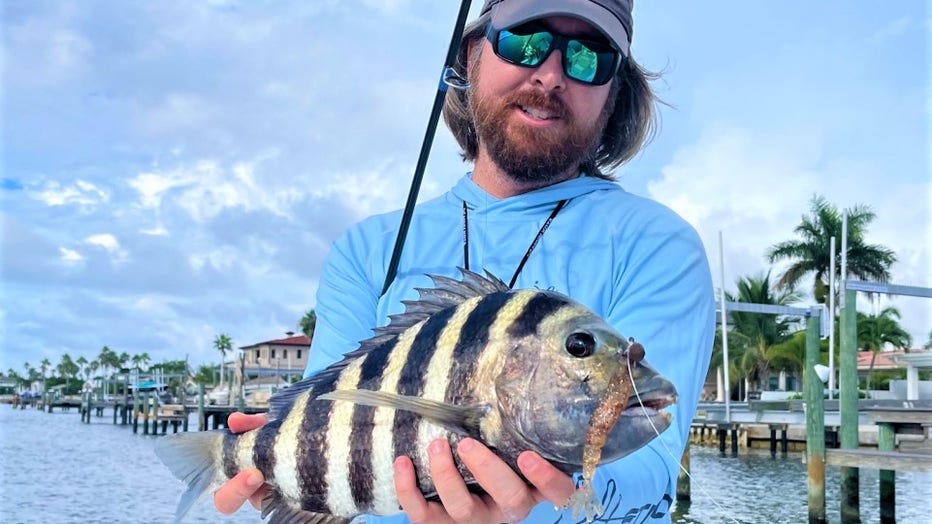
Sheepshead (Credit: Hubbard's Marina)
Snook action has been great this past week around our area. However, you have to find those areas of clearer waters unaffected by the red tide. For example, inside John’s Pass we will see huge numbers of snook that should be feeding well but they will either be moving or just simply not feeding when that water is a bit darker and noticeably impacted from the red tide presence. When that water clears and the right tidal range is occurring, it’s like a light switch gets flipped and they go nuts.
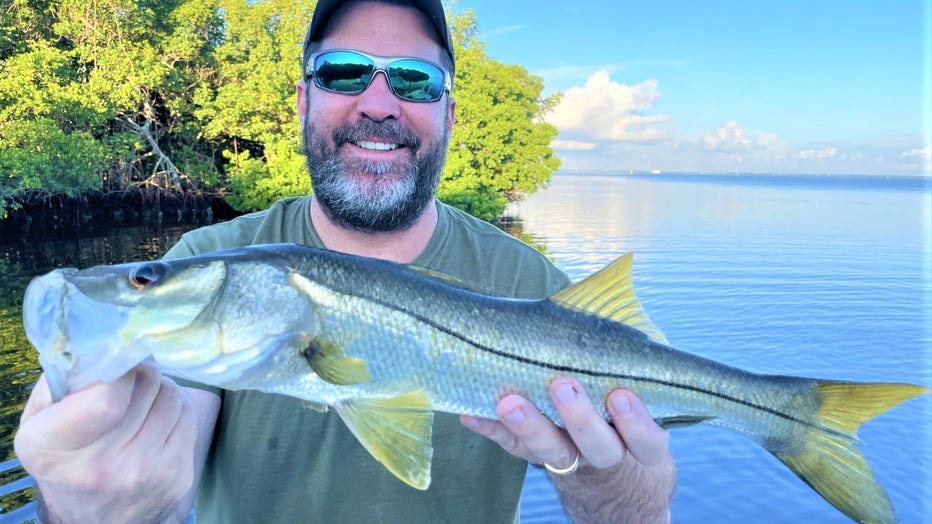
Snook (Credit: Hubbard's Marina)
Further back in the bay, where there’s clearer waters consistently, we are seeing a more steady and expected snook bite. The big ones are still super lazy in the daytime feeding most actively at night and around those shaded areas, deeper areas, or where current is moving more and they can find a little hiding spot to ambush passing baits.
Redfish bites have been going well this past week. Like the snook, they are feeding best through the night and into the early mornings and around dusk too. However, during the day if you find schools of mullet, likely there will be some actively feeding redfish following them, eating up any spooked crustaceans or small bait fish. We are seeing those soft plastic paddle tails in white working best with a small jig head depending on the depth you fish.
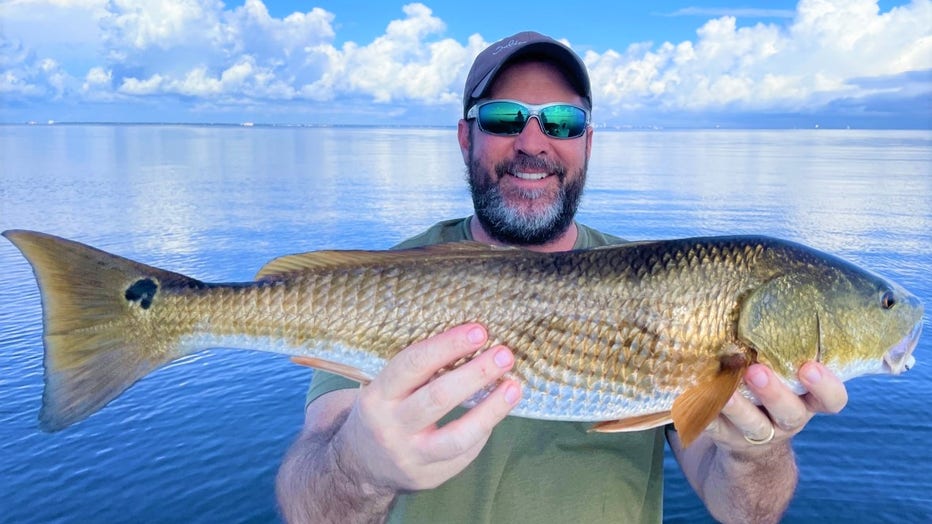
Redfish (Credit: Hubbard's Marina)
Tripletail are biting well around the area too. We are seeing these guys around virtually any floating debris even near shore too. Markers and buoys of Tampa Bay and the intercoastal are holding triple tail too. The ‘power prawn,’ the ‘DOA Shrimp’ or even a live shrimp has been the hot baits to sight cast these great eating prehistoric looking fish. Remember, they have to be 18 inches to keep now so they really take a big one in order to harvest them but it’s still tons of fun on lighter tackle when your sight fishing these guys passing that floating buoy or debris.
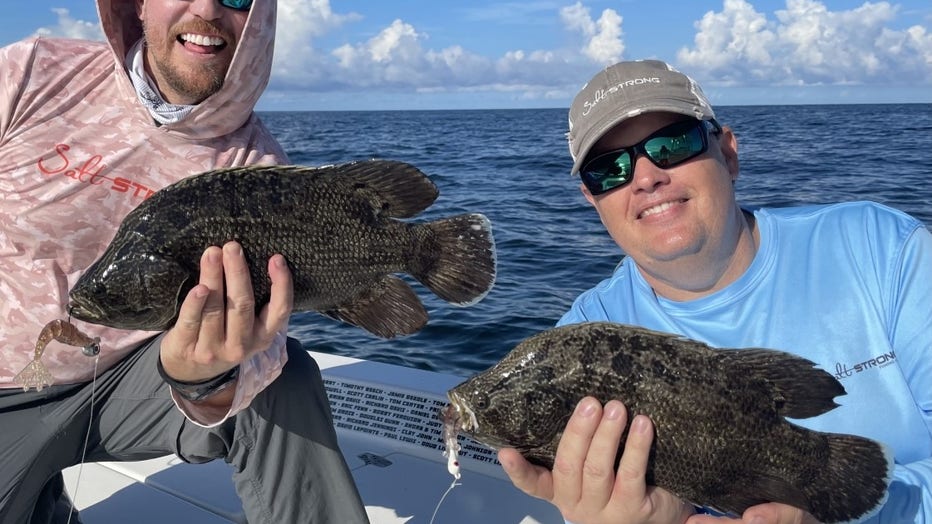
Tripletail (Credit: Hubbard's Marina)
Mackerel are super thick around the bay and around the beaches right now. There are acres of bait around the bay especially around the bridges and flats and that’s attracting plentiful mackerel feeding well on virtually anything you throw at these areas that’s super flashy and fast moving.
Trout have still been biting well around those deeper flats and edges and inside cuts of those more shallow grass flats too. They are looking for those slower moving soft plastics and the overcast days plenty of top water action too. They will also stack up on dock lights and bridge lights at night around moving water where bait is plentiful.
Tarpon are still around the area and feeding well around the local bridges and mouths of passes and the bay when the tide is running well, flushing plentiful bait out of the area to where they are most actively feeding. Look for them on those big outbound tides ready to ambush passing mullet, ladyfish, crabs or larger white bait like threadfins.
Near shore
Hogfish action is going better and better near shore as of late. This past week we had some trips where a half dozen keeper hogfish were caught. We’re hoping to see this number continually grow especially with the cold fronts starting up.
As the water cools this time of year, that will bring the hogfish back to the ledges. Concentrations of them will make it them easier to target and catch via hook and line. They love those live shrimp and lighter tackle approaches. Here’s a great video to help you prepare for the upcoming hogfish push.
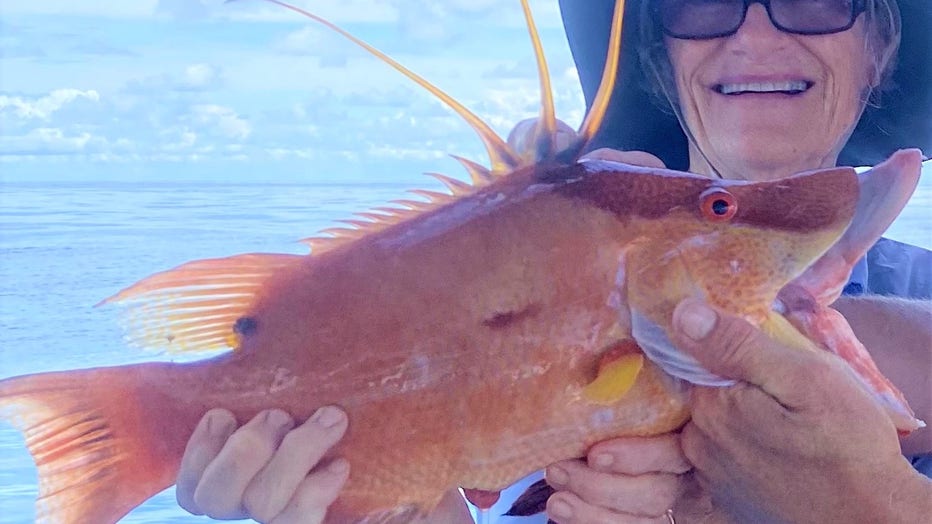
Hogfish (Credit: Hubbard's Marina)
Mangrove snapper are really prolific near shore right now and we are doing well catching them using lighter tackle and smaller chunks of threadfin or sardine on that double snell rig. Also, using live shrimp and the mangrove snapper techniques outline above are great ways to target those mangrove snapper too.
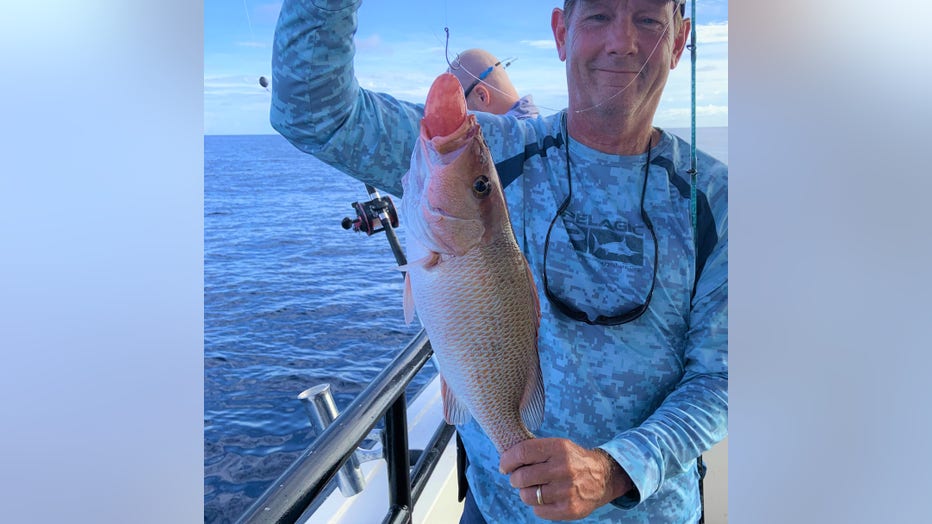
Mangrove snapper (Credit: Hubbard's Marina)
Lane snapper, like the mangroves, are super prolific and are even biting better around the near shore waters. We can see them using squid, shrimp or the threadfins and they are much less leader-shy compared to the mangrove snapper. So, we tend to catch them most often near shore. Look for good lane snapper concentrations starting around 60-80 feet of water.
Mackerel are thick near shore right now feeding well on those big concentrations of bait that are hanging around the beaches, buoys and big structures near shore. We are seeing them trolling out on our longer trips and the half day by trolling planners with spoons.
Offshore
Mangrove snapper are coming up well offshore, beyond 100 feet of water, on those cut threadfin chunks or smaller pinfish. Unfortunately, getting live bait out there with red tide persisting in the area has been extremely challenging but some are having good luck. The most common way to target them is with that double snell set up with around 5-6 ot hooks and about 40-50lbb test.
Amberjack are biting better this past week for us out in the deepest offshore waters. We are seeing them on the jigs, with big live baits, and occasionally even trolling too. They are most active and concentrated past 140 feet of water, but you can find them a little shallower too. However, deeper you go the bigger they get.
Scamp grouper are really becoming a targeted species with them coming up on strips of squid, threadfin, small diamond jigs and smaller to medium pinfish. We see them around those ledges, peaks, springs and wrecks out in deeper waters but most commonly on the ledges were hunting the gag grouper on.
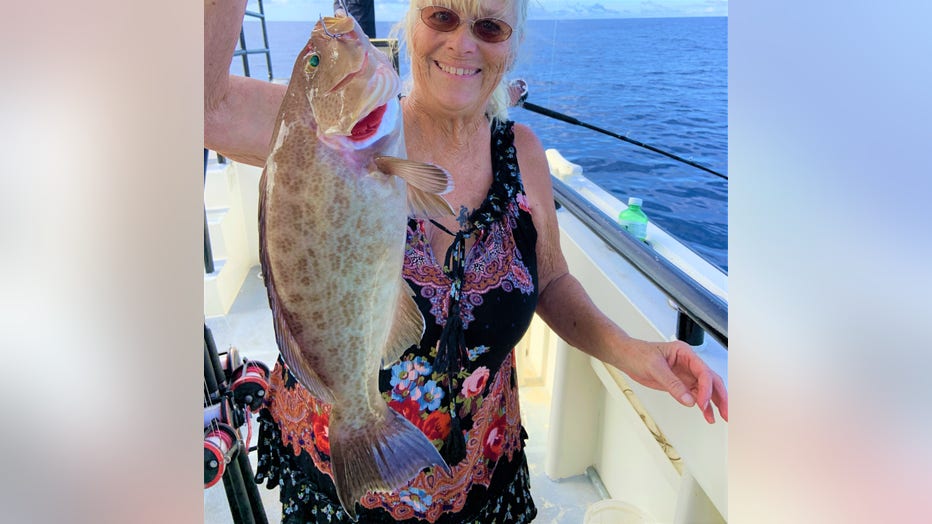
Scamp grouper (Credit: Hubbard's Marina)
Gag grouper are tougher to hone in on lately around our area. You can find them, yes, but finding big concentrations is difficult. Up to our north, they are seeing higher concentrations than normal.
Wahoo are definitely around offshore right now and we’re seeing plenty of them caught as of late. We are seeing them mostly on the Nomad lures or the rapla xrap magnums. They love those fast-moving plugs or the Nomad Mad Macs that are similar to the yozuri bonita lures but they seem to dive deeper and cruise straighter.
Kingfish are around offshore too. We are seeing them trolling, on the flat lines and occasionally while vertical jigging and that should improve as water temperatures get right. However, we are seeing the tuna action pick up really well for us around the offshore waters with tuna coming up the same ways the kingfish are but they just seem more aggressive and prolific right now!
DON’T BE A FOOL, bring a venting tool & Descending device
Keep in mind the importance of dead discards and discard mortality when engaged in near shore or offshore fishing. How many do you know right now that are all for catching and releasing snook, redfish, and trout but will be the first in line to kill a mangrove snapper, gag grouper, or red snapper? But the attitude completely changes when discussing these offshore species?
Plus, the same person inshore that will hold their breath and wet their hands before handling a breeder snook will go offshore and then cull through 20 red snapper before keeping their two red snapper they deem large enough to fill their two-fish bag limits. Meanwhile, the other 18 they released will often end up suffering fatal damage if not properly descended or vented?
Please help us to spread the word on the importance of descending or venting your released fish. Descending devices are most easy to use and quick to pick up on their use. They are most effective for most anglers.
However, an expert and precise angler with proper training and tons of experience can use a venting tool properly with similar outcomes. A venting tool requires you to pierce the fish while most descending devices are much less invasive. While using a venting tool, it is imperative you pierce them in the exact right spot, and you do not go but a quarter-inch or less in the fish. Most venting tools require you to ‘choke up’ on the tool to prevent over-penetration into major organs.
When fishing deep water, especially in the hot summer months, please make sure to treat all fish intended to be released like that breeder snook inshore and minimize the time it takes you to get him from the bottom to the boat using heavier proper tackle, not an ultra-light spinning reel.
Then once onboard, minimize the time out of the water. Then use a proper de-hooking tool and then, for the love of God, use a descending device or venting tool PROPERLY to ensure that fish has a chance to live another day.
Three things will help ensure the survivability of those fish released offshore:
- Making sure they are brought up quickly and do not expend all their energy in the fight.
- Make sure they are unhooked smoothly, easily, and as quickly as possible.
- Finally, make sure they spend the least amount of time at the surface at negative pressures where barotrauma exponentially increases its effect with each passing second.
Also, keep in mind when the water is warm, there is less dissolved oxygen content and the chances of barotrauma increase even more while its effects can be even more deadly.
LINK: Here’s all the information and more on barotrauma and how to mitigate that fatal damage to your future offshore catch
**Note: I recommend the Salt Strong articles at the bottom of the page under ‘webpages.’ I helped them develop those personally.
STATE SURVEY to improve recreational data and access
It is imperative that you have your Gulf Reef Fish survey endorsement on your fishing license.
You should get one if you are a private recreational angler or diver fishing from a private boat anywhere in Florida who intends to harvest, attempt to harvest or possess one or more of the following reef fish species: mutton snapper, yellowtail snapper, hogfish, red snapper, vermilion snapper, gag grouper, red grouper, black grouper, greater amberjack, lesser amberjack, banded rudderfish, almaco jack, gray triggerfish, Gag grouper, Red grouper, Scamp grouper, Mangrove snapper, Lane snapper, Kingfish, Tuna, or Mahi mahi.
Here is all the information and more on that program and how you can sign up.
TERMS OF REFERENCE:
INSHORE – from the back bays out to the bridges and including right on the beaches
NEAR SHORE – From the beaches out to 20 miles, or up to 100ft of water
OFFSHORE – from 20 miles or 100ft and beyond
For more fishing reports, photos, videos and more check out Hubbard’s Marina on Facebook, Instagram, YouTube, or Snapchat. Just simply search "HubbardsMarina" and do not forget our family motto, "If you’re too busy to go fishing, you’re just too busy!

